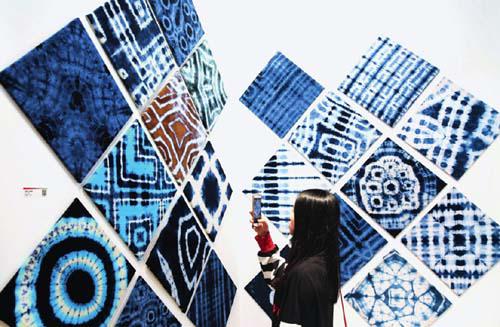Textile Art in White and Blue


BLUE calico, a kind of home-made fabric col- ored by plant dyes, is commonly seen in Chinese peoples daily life, in particular in South China. Clothes, bedspreads, quilt covers, scarves, handkerchiefs, door curtains, or even wrappers, made of the plain and elegant blue-and-white fabric, can be seen almost everywhere. The cloth incorporates a creative array of patterns that resonate with peoples aesthetic tastes.
Nantong Blue Calico
Located in the alluvial plain of the Yangtze River Delta, Nantong, in East Chinas Jiangsu Province is a perfect place for a cotton plantation. Back in the 14th century, as local textile technology developed and became popularized, almost every household in Nantong had wooden spinning wheels and looms, which helped shape the location into a famous textile base.
As the legend goes, an accident led to the birth of blue calico: One day, while local people were drying cotton cloth in the open air, a gust of wind blew some pieces onto a stack of the indigofera plant. When people found them, they had been stained with blue blotches and looked unexpectedly lovely. It was after this that the indigo dyeing process began.
With rivers crossing the city, the area surrounding Nantong has been endowed with a warm and humid climate, very suitable for the growth of indigofera. With the invention of the dyeing method, coupled with the popularization of textiles, the local dyeing and weaving industry boomed. When it came to Ming (1368-1644) and Qing (1644-1911) dynasties, those workshops specializing in weaving and dyeing blue calico clustered together to form a sizable mar-ket. The local printing and dyeing craftsmanship also spread nationwide.
Nantong blue calico can be divided into two categories: blue background with white patterns and white background with blue patterns.
Selection of greige cloth is the first step needed to produce blue calico. Usually first-grade greige is favored. The required pattern is usually engraved in a pattern board, which is made of two or three layers of kraft paper bound together. After the engraving is done, both sides of the board are brushed with boiled tung oil and dried. Once this process is repeated two or three times, the board can be flattened, ready for use. The board can be used repeatedly. In designing the calico pattern, the designer should take into account both duration of the board and features of the pattern. Usually in a bold and exaggerated way, rough and vigorous patterns are created, stirring peoples imagination, leaving an evident mark of an ancient art.
The next step is starching. First, the pattern board is placed on the greige cloth, followed by a spread of the dye-resistant agent, a mixture of soybean powder and pulverized lime. Along the hollowed parts of the pattern board, the dye-resistant mixture would seep through to the greige cloth, thus forming a protective layer on certain parts of the cloth. It takes two days for the greige cloth covered with the dye-resistant protective layer to dry. It would then be put into the coloring agent made with the indigofera juice. The parts without the protective layer are dyed blue, leaving the other areas white.
The dye is stored in a large vat, which can be used for generations. The coloring effect is determined by the quality of dye, which makes the dye a core part of a dye house. The guardian of the dye vat is usually the most respected person in a dye house, as he or she is the only person who knows the recipe for the dye.
Once the dyed cloth is dry, the dye-resistant protection cover can be removed. The whole process is all completed manually. The length of a blue calico cloth is limited to below 12 meters. The sight of the cloths fluttering in the breeze drying on seven-meterhigh racks is quite spectacular.
The serene blue and pure white form a dazzling array of auspicious patterns on the cloths. In 2006, the Nantong blue calico dyeing and printing tech- nique was included into Chinas national intangible cultural heritage list.
Guizhou Batik
Guizhou batik, wax-resistant dyeing of cloth, can be traced back to over 2,000 years ago. It stands out with unique color, simple and elegant patterns, and rich cultural connotations among all forms of folk art in Guizhou Province.
There are some incongruous conjectures about the origin and evolvement of batik. Nonetheless, batik is a distinctive textile technique in Guizhou, and prevalent in ethnic minority areas with such inhabitants like Miao, Bouyei, and Shui people.
In those areas, delicate or rough batik works can be found in peoples clothes, accessories or even some small daily use articles like handkerchiefs. Guided by their mothers or senior female family members, local girls begin learning how to make flower patterns at the young age of six or seven. When they reach their teens, they have already mastered the skill of making exquisite patterns. Then they begin to prepare their dowries, including sets of batik garments and articles of daily use. Among these, some small batik decorations may be taken as a token of love. It usually takes a girl five to six years to prepare her dowry. The more abundant the dowry, the more admired the girl will be. Thus, she will have more advantages in finding her loved one.

Depending on the ethnic group or the branch of an ethnic group, the parts of a dress with batik decoration differ: It may appear on the top, the skirt, or even cover the whole dress. Some groups only have batik decoration on their head adornments or belts. Usually the tradition of their ethnic group prescribes the specific parts of their dress or apparel items that need batik adornment, which cant be changed randomly.
The Guizhou batik production process is similar to that of Han peoples traditional dyeing and printing. The difference lies in the use of beeswax as the dye-resistant agent, which makes batik patterns more diversified and flexible. Besides the use of traditional patterns, the maker can also create new ones to show their likings and aesthetic preference. Moreover, without a limit for cloth width, in light of its expected purpose, different cloth widths can be used with suitable patterns applied in relation to the wearers age, personality, and preference. In addition, the wax layer can be applied twice to the dyed cloth piece, in order to diversify the color blue, giving it different hues.
People draw patterns with a copper pen dipped in melted beeswax. After cooling, the wax cover may have cracks in the dyeing process caused by incessantly rolling and turning the fabric piece. The dye seeps into the white greige cloth along the cracks, thus creating the randomly-formed pattern, called crack pattern, which resemble the cracks in porcelain glaze. Therefore, even if for the same design, in the dyeing process, different crack patterns can be generated.
The indigofera plant is the major dyeing material for traditional Guizhou batik. With it, cloth can be dyed in a quite low temperature, and the batik also has good of fastness, which gives this plant an advantage against other vegetable dyes that can only dye fabric at a high temperature, or risk fading. However, at high temperatures, beeswax would melt, unable to maintain the original patterns, which made dyeing in other colors impossible in ancient times. Modern wax dyeing techniques have made a full range of colors possible.
As a folk art, Guizhou batik has been an indispensable part of ethnic cultural activities in Guizhou, including festivals, weddings, funerals, and religious activities. The batik production activities are closely associated with the local ethnic cultural background and living environment, which has made it a unique visual language that tells locals cultural, religious, and historical stories to the outside world. In 2006, Guizhou batik was included in Chinas national intangible cultural heritages.
Tie-Dyeing of Bai Ethnic Group
Tie-dyeing, also known as plangi or bandhnu, is an ancient dyeing skill. Dali in southwest Chinas Yunnan Province is the central place of origin for textile products featuring this dyeing technique, and people of the local Bai ethnic group are their major producers, earning the process a name Dali tie-dyeing, or Bai tie-dyeing. Most famous for the dyeing craftsmanship, Zhoucheng in Dali was named as the Town of Ethnic Tie-Dyeing by the then Ministry of Culture.
Evidence shows that tie-dyeing originated in the Yellow River basin. Around the fourth century as the dyeing craft became mature, production increased. Apart from simple patterns on some parts of a fabric piece, a full set of patterns covering a whole piece of fabric could also be seen in tie-dyed works produced during this period, which were widely used in womens dresses. When it came to the Tang Dynasty(618-907), the tie-dyed textile products became even more popular. In particular, the works with exquisite flower patterns popular in the palace were trend setters. At the height of the Tang Dynasty, the tiedyeing technique also spread to neighboring countries including Japan, from which the dyeing craft was brought to Chinas Yunnan Province. The ancient dyeing craft then took root there thanks to abundant water resources and a favorable climate, which supported a variety of blue-dye plants. After the 14th century as the Bai dyeing craft in Dali developed to its full potential, the local dyeing guild came into being, and local tie-dyed products earned a great reputation. In the early 20th century, tie-dyeing became a household craft. Places represented by Zhoucheng, renowned for its high density of household tie-dyeing workshops, became centers of the ancient tie-dyeing craft.
White cotton cloth and ramie cotton fabric is taken as the material for tie-dyeing with its blue dye coming from plants such as indigofera, woad root, and Chinese mugwort, which are native to the nearby Cangshan Mountain. As the demands for the tiedyed products increased, local people began to plant woad themselves. From March to April, they reap the plant and then soak it in water before pouring the liquid into the dye vat. After mixing the required amount of lime or soda, the dye liquid then can be used in coloring cloth.
As its name suggests, the process is divided into“tie” and “dye.” First tie and sew some parts of the fabric piece into patterns, and then dye it. As the tied parts cant be colored, the patterns are achieved when unfolding the cloth.
After the cloth piece is selected, workers would crease, pinch, or tie some parts of it, and then tightly sew or bundle them with thread. Strings of knots appear on the fabric piece, which is then immersed in the dye vat before being taken out to dry. After drying, it is put back into the dye vat again. With each immersion, the color would be more intensified. The process is repeated until a desired hue is achieved. Once dried, stitches are removed out of the knots, and the cloth piece is then smoothed out to show the parts which have been sewn and uncolored, forming patterns in white against the deep blue background.
Due to difference in stitches, the tied knots show differences in tightness. Therefore, penetration degree of the dye varies. Actually, differences even appear in works of the same crafter. Therefore, each tie-dyed work has its unique art features, which are unattainable in a machine dyeing process. In addition, in the dyeing process, due to the penetration effect, boundaries of patterns would also show the gradually varied colors from blue to white, which is totally naturally formed, thus adding an extra dimension to the tie-dyed piece.
In recent years, by combining the ancient tie-dyeing craftsmanship with modern dyeing and printing technology, local Bai women in Dali have introduced multi-color tie-dyeing techniques.
In 2006, the tie-dyeing craftsmanship of the Bai people was included into Chinas national intangible cultural heritage list.

